Tool reduces empiric antibiotic use and blood work

Among the conditions that nurses assess newborns for is early-onset sepsis (EOS), a blood infection that most often appears within 24 to 48 hours of birth. Diagnosis of EOS requires a venipuncture blood test. In 2018, a team of physicians and nurses from three of Cleveland Clinic’s birthing hospitals – main campus, Fairview Hospital and Hillcrest Hospital – launched a sepsis risk calculation quality initiative to examine the healthcare system’s protocol for diagnosing and treating babies with early-onset sepsis.
Advertisement
Cleveland Clinic is a non-profit academic medical center. Advertising on our site helps support our mission. We do not endorse non-Cleveland Clinic products or services. Policy
Prior to the initiative, babies were treated if they met certain parameters for EOS, including the following:
Two physicians in Pediatric Hospital Medicine, Suet Lam, MD, MPH, MS, and Colleen Schelzig, MD, initiated the sepsis risk calculation quality initiative (SRC QI). Nora Knipper, MSN, RN, NEA-BC, nurse manager of the mother baby unit at Fairview Hospital was part of the SRC QI team.
“We met many times to hash out how to prevent babies from being separated from their moms and unnecessarily placed on antibiotics,” says Knipper. The group examined the literature on the effect of antibiotic use on newborns and received insight from a group from Fairview Hospital’s NICU that had done an antimicrobial stewardship project.
The SRC QI project team decided to utilize the neonatal early-onset sepsis calculator, an online tool that calculates the probability of EOS based on maternal risk factors and the newborn’s clinical presentation.
Cleveland Clinic’s birthing hospitals began using the tool in June 2018. If a baby is at risk for EOS, a physician in labor and delivery contacts the newborn nursery, where a clinical nurse begins inputting information on the baby and mother as it’s received. This information includes gestational age, highest maternal antepartum temperature, duration of rupture of membranes, maternal GBS status and type of intrapartum antibiotics.
Advertisement
Once the baby is transferred to the nursery, the nurse examines the newborn and completes the form, noting any clinical illnesses or physiologic abnormalities. The calculator then provides a risk assessment per 1,000 births based on the input and a clinical recommendation. A pediatrician also completes the tool, then compares results with the nurse’s results. If they are in agreement, they follow the recommendation. If not, they go through the protocol again to see where they disagreed and get in accordance.
The tool, which was built into Cleveland Clinic’s electronic medical record and went live in early April 2019, has led to a decrease in empiric antibiotic use and blood work evaluations in more than 500 infants at Fairview Hospital and Hillcrest Hospital. Here is some other supporting data from June through October 2018:
But numbers don’t tell the whole story. The new protocol has supported Cleveland Clinic’s broader goal of providing a family-focused environment. “If you have a venipuncture, it is done in the nursery,” says Julie Gamary, BSN, RNC-MNN, assistant nurse manager of the mother baby unit at Fairview Hospital. “So when we do a blood culture, we’re separating families and it’s more traumatic on the babies.”
Advertisement
With the new protocol, there is less separation – and less stress on new parents. “Babies and parents aren’t separated unnecessarily, and the parents aren’t traumatized when the nurses draw their baby’s blood,” says Knipper. “The new protocol better supports our initiatives for mother-baby bonding, breastfeeding, rooming-in and couple care.”
Advertisement
Advertisement

How hospitals can weave ethics into daily nursing practice to strengthen patient-centered care

Mobility carts provide exercises and tools

Nurse researchers explore the relationship between readmission risk scores and acute care transfers

Guiding nurses amid a constantly evolving healthcare landscape

Ideation session generates solutions to medication administration errors

Caregivers spearhead changes that improve patient care, shape hospital culture

Building a culture that supports, engages and empowers nursing staff

Nurses harness cutting-edge technology as a bridge to healing